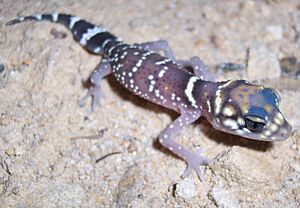Underwoodisaurus milii facts for kids
- For the African genus called "barking geckos", see Ptenopus
Quick facts for kids Underwoodisaurus milii |
|
|---|---|
 |
|
| Conservation status | |
| Scientific classification | |
| Genus: |
Underwoodisaurus
|
| Species: |
milii
|
| Synonyms | |
|
|
The thick-tailed gecko (Underwoodisaurus milii) is a special kind of gecko. Geckos are lizards that belong to the Carphodactylidae family. This gecko is also known as the barking gecko because of its loud, barking sound it makes when it feels threatened.
It gets its common name "thick-tailed" from its plump, round tail. Other geckos in the same group, like Uvidicolus sphyrurus, are also called thick-tailed geckos.
Contents
What's in a Name?
The scientific name milii was given to this gecko to honor a French sailor and naturalist named Pierre Bernard Milius. A naturalist is someone who studies nature.
Appearance and Features
The thick-tailed gecko has a reddish-brown body with bands of white and yellow spots. Its belly is usually a lighter color. These geckos typically grow to be about 12 to 14 centimeters (5 to 5.5 inches) long, including their tail.
Their original tail is black with light-colored bands. However, if a gecko loses its tail and it grows back, the new tail will look different. It will have very little pattern on it.
Where They Live
You can find the thick-tailed gecko in the southern parts of Australia. They prefer to live in rocky areas. Unlike many other Australian geckos, they can handle colder temperatures pretty well.
These geckos are nocturnal, which means they are active at night. During the day, they hide under rocks or in burrows to stay safe and cool.
What They Eat
Thick-tailed geckos are carnivores, meaning they eat other animals. Their diet mainly consists of insects. They also eat small vertebrates, which are animals with backbones.
Why They Huddle Together
It's unusual for reptiles to gather in groups, but thick-tailed geckos do! They often huddle together in their hiding spots during the day. Scientists are still learning why they do this.
One reason might be to stay warm. When they group up, their bodies help each other keep warm, especially on cooler days. This behavior might even be an early form of social behavior for these geckos.
How They Behave
When a thick-tailed gecko feels scared or threatened, it will arch its back. Then, it will make a sharp "barking" sound to try and scare away whatever is bothering it. They also make this sound during their breeding season.
Like some other gecko species, U. milii has a unique habit. After they eat, they will lick their own eyes. This helps them keep their eyes clean, as geckos don't have eyelids to blink.
Where They Are Found
The thick-tailed gecko lives in the southern regions of Australia.
In Western Australia, they are found across the southwest, in the goldfields, and in the wheatbelt areas. They also live in the Nullarbor region to the east and as far north as Shark Bay. You can also find them on the Houtman Abrolhos islands and the Recherche Archipelago.
Conservation Status
The thick-tailed gecko is doing well in terms of its population. The IUCN Red List, which tracks the health of animal species, lists it as "Least Concern." This means their numbers are stable and they are not currently at risk of disappearing.
In some parts of Australia, you can even keep a thick-tailed gecko as a pet, but you need to have the right license.


